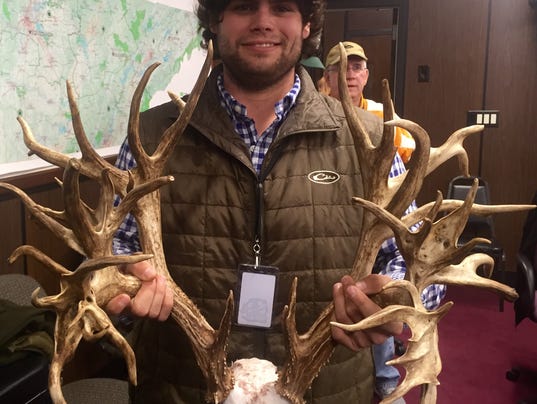Stephen Tucker killed the 47-point buck in November.
It's official — Gallatin resident Stephen Tucker shot a world record whitetail deer in November in Sumner County.
Now all that's left is certification.
Tucker, 27, killed the trophy buck with a muzzleloader, but a 60-day drying out period had to take place in order to allow for possible shrinkage of the antlers.
That period ended on Monday, and a measurement of the 47-point rack was made by a Boone and Crockett panel of four judges, who gave the deer a score of 312 3/8 inches.
That is larger than the non-typical current net world record of 307 5/8 inches killed in 2003 by Tony Lovstuen in Albia, Iowa. That deer had 38 points.
The world record for a deer killed by a hunter is pending official certification, which won’t take place until the Boone and Crockett awards banquet in 2019. The date and site for the awards banquet has not yet been set
I just tried not to think about whether it was the world record or not during the drying out period," Tucker said. "The last week was probably the worst part of the whole time. I didn't want to get myself real worked up about it because I didn't want to be let down if it wasn't the record. I just kept telling myself, 'It's going to be what it's going to be.'"
Deer racks are measured from several angles at the farthest points using the official Boone and Crockett scoring method.
A non-typical rack is asymmetrical and does not have the same number of points on each side like a typical rack.
The measurement took place at the Tennessee Wildlife Resources Agency, and Tucker was allowed to watch. It took nearly four hours to complete.
"I figured it would take them a pretty good while to measure it," Tucker said. "The waiting wasn't too bad until they walked out of the room to go tally it up. That's when I realized it was close. We were about to find something out for sure."
TWRA District 21 captain Dale Grandstaff, who also is a Boone and Crockett judge, never expected to measure a rack as large as Tucker's deer.
"I never thought I would ever see this in Tennessee," said Grandstaff, who was part of the official judging panel. "Actually, I never thought I would see one over 300 inches."
Grandstaff said he would notify Boone and Crockett of the pending world record score later Monday.
Tucker then will be invited to the Boone and Crockett awards banquet in spring 2019, where a panel of two judges will re-score the antlers, Grandstaff said.
Gallatin resident Stephen Tucker talks about his potential world-record deer, which he killed on Monday.
Also on Monday, the TWRA declared the deer a new state record. It beat the record set in 2000 in Sumner County by Dave Wachtel, whose deer netted 244 3/8.
Grandstaff scored the antlers the day Tucker killed the deer and said he was very conservative with his measurements at that time.
"I knew there were places that it would possibly gain with this measurement because I was so conservative with it in November," Grandstaff said. "I did that so that nobody would get their feelings hurt if it didn't make it. It did shrink a little bit here and there, but the thing that was amazing to me was that we as a group put our minds together and scored, and it and my deductions from the typical frame and the deductions from the typical frame today were exactly the same at 4 7/8 as they were for that first measurement."
Tucker’s deer weighed about 150 pounds and was estimated to be 3½ years old.
Tucker said he shot the deer from about 40 yards away on a farm his family has leased for 40 years. He said he had the deer processed and plans to eat it.
Tucker said he has not yet decided what he will do with the antlers, which could beworth more than $100,000.
"I'm just going to go with the flow," Tucker said. "To be honest, I was waiting for this (score) before I put a lot of thought into it. I don't have any specific plans for it at this point. All the phone calls and stuff had slowed down quite a bit in the last couple of weeks. I'm sure it will pick back up again after this."
Tucker probably will have a replica of the antlers made that could be put on display.



![Brad Julian Jr. of Oklahoma City holds the European mount of the whitetail he shot near Jones during the gun season. The buck's score will be a world record for a 3 x 3 main frame. George Moore measures the antlers for Boone & Crockett while Brad Julian Jr. looks on. [PHOTOS BY ED GODFREY, THE OKLAHOMAN]](https://cdn2.newsok.biz/cache/w640-16995a738eb4108c99646840ca9fb2fd.jpg)

